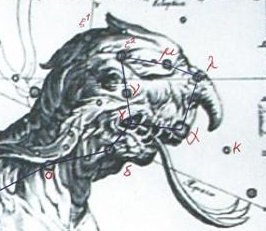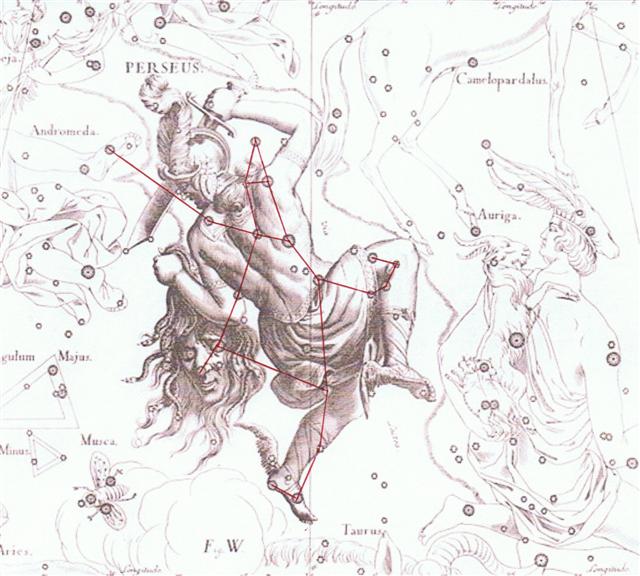It seems as if the river Eridanus could have been used to quickly transport the attention across the sky from the silent bird in autumn to the busy Bharani fly in spring. Alternatively the beam of Libra could have served such a purpose.
The Romans counted 'February 23 as Terminalia, in a way their last day: ... The leap day was introduced as part of the Julian reform. The day following the Terminalia (February 23) was doubled, forming the 'bis sextum - literally 'double sixth', since February 24 was 'the sixth day before the Kalends of March' using Roman inclusive counting (March 1 was the 'first day'). Although exceptions exist, the first day of the bis sextum (February 24) was usually regarded as the intercalated or 'bissextile' day since the third century. February 29 came to be regarded as the leap day when the Roman system of numbering days was replaced by sequential numbering in the late Middle Ages ... At the time of rongorongo day *227 (alluding to π) was at the Full Moon when the Sun reached Menkar (the Nose of the Sea Beast). Instead of *AUGUST 21 - reflecting March 21 defined as spring equinox - we should look at *AUGUST 25 (5 months after the Julian equinox), because this was when the Sun reached the Star (Kakkab) high up at the North Pole. At the other end of the year was *FEBRUARY 23 (Terminalia) and τ Persei (at his neck):
408 (Cb1-16) - 4 - 4 = 400. This must have been the place for a pole. ... In the arabesque of interlaced motifs, one can mark those where the theme of 'pulling down the structure' is in evidence. The powerful Maori hero Whakatau, bent on vengeance, laid hold of the end of the rope which had passed round the posts of the house, and, rushing out, pulled it with all his strength, and straightaway the house fell down, crushing all within it, so that the whole tribe perished, and Whakatau set it on fire. This is familiar. At least one such event comes down dimly from history. It happened to the earliest meetinghouse of the Pythagorean sect, and it is set down as a sober account of the outcome of a political conflict, but the legend of Pythagoras was so artfully constructed in early times out of prefabricated materials that doubt is allowable. The essence of true myth is to masquerade behind seemingly objective and everyday details borrowed from known circumstances. However that may be, in many other stories the destruction of the building is linked with a net. Saxo's Amlethus does not pull down pillars; he reappears at the banquet set by the king for his own supposed funeral, like Great-Land-Master himself. He throws the knotted carpet net prepared by his mother over the drunken crowd and burns down the hall. In Japan the parallel does not go farther than that but it has its own relevance nevertheless. It suggests the fall of the House of Atreus. The net thrown by Clytemnestra over the king struggling in his bath cannot have come in by chance. But this is an uncertain lead as yet. The Sacred Book of the ancient Maya Quiche, the famous Popol Vuh (the Book of Counsel) tells of Zipacna, son of Vucub-Caquix (= Seven Arata). He sees 400 youths dragging a huge log that they want as a ridgepole for their house. Zipacna alone carries the tree without effort to the spot where a hole has been dug for the post to support the ridgepole. The youths, jealous and afraid, try to kill Zipacna by crushing him in the hole, but he escapes and brings down the house on their heads. They are removed to the sky, in a 'group', and the Pleiades are called after them. Then there is a true avanger-of-his-father, the Tuamotuan Tahaki, who, after long travels, arrive in the dark at the house of the goblin band who tortured his father. He conjures upon them 'the immense cold of Havaiki' (the other world) which puts them to sleep. Then Tahaki gathered up the net given to him by Kuhi, and carried it to the door of the long house. He set fire to the house. When the goblin myriads shouted out together 'Where is the door?' Tahaki called out: 'Here is it.' They thought it was one of their own band who had called out, and so they rushed headlong into the net, and Tahaki burned them up in the fire. What the net could be is known from the story of Kaulu. This adventurous hero, wanting to destroy a she-cannibal, first flew up to Makalii the great god, and asked for his nets, the Pleiades and the Hyades, into which he entangled the evil one before he burned down her house. It is clear who was the owner of the nets up there. The Pleiades are in the right hand of Orion on the Farnese Globe, and they used to be called the 'lagobolion' (hare net). The Hyades were for big game ...
|








